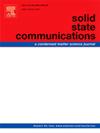High spin polarization and half-metallic ferromagnetism in novel Half–Heusler FeCrX (X = S, Se and Te) alloys using first-principles calculations
IF 2.1
4区 物理与天体物理
Q3 PHYSICS, CONDENSED MATTER
引用次数: 0
Abstract
First-principles computations using the density functional theory are used to explore the structural, opto-electronic, magnetic, and thermoelectric properties of new predicted half-Heusler FeCrS (X = S, Se, and Te) materials. Two methods are used for estimating the correlation-exchange potential: generalized-gradient approximation GGA and modified Becke-Johnson Tb-mBJ. Furthermore, the examined half-Heusler are mechanically stable, and both show negative formation energy, indicating the prospect of synthesis and stabilization. Additionally, the structural characteristics are looked into for nonmagnetic and ferromagnetic states. The electronic band structure reveals that a band gap of 1.12, 0.89, and 0.86 eV has been found for FeCrS, FeCrSe, and FeCrTe, respectively, for the spin-down channel. For each of these alloys, the Curie temperature has also been determined. The optical parameters show that all compounds have absorption in the UV–visible regions, which shows that these materials are good contenders for optoelectronic and solar cell applications. The thermoelectric characteristics are computed against chemical potential. Due to the higher value of Seebeck coefficient, power factor, figure of merit, and electrical conductivity, FeCrTe is the best material for transport applications.
求助全文
约1分钟内获得全文
求助全文
来源期刊

Solid State Communications
物理-物理:凝聚态物理
CiteScore
3.40
自引率
4.80%
发文量
287
审稿时长
51 days
期刊介绍:
Solid State Communications is an international medium for the publication of short communications and original research articles on significant developments in condensed matter science, giving scientists immediate access to important, recently completed work. The journal publishes original experimental and theoretical research on the physical and chemical properties of solids and other condensed systems and also on their preparation. The submission of manuscripts reporting research on the basic physics of materials science and devices, as well as of state-of-the-art microstructures and nanostructures, is encouraged.
A coherent quantitative treatment emphasizing new physics is expected rather than a simple accumulation of experimental data. Consistent with these aims, the short communications should be kept concise and short, usually not longer than six printed pages. The number of figures and tables should also be kept to a minimum. Solid State Communications now also welcomes original research articles without length restrictions.
The Fast-Track section of Solid State Communications is the venue for very rapid publication of short communications on significant developments in condensed matter science. The goal is to offer the broad condensed matter community quick and immediate access to publish recently completed papers in research areas that are rapidly evolving and in which there are developments with great potential impact.
 求助内容:
求助内容: 应助结果提醒方式:
应助结果提醒方式:


